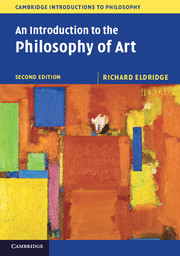Book contents
- Frontmatter
- Contents
- Acknowledgments
- Preface to the second edition
- 1 The situation and tasks of the philosophy of art
- 2 Representation, imitation, and resemblance
- 3 Beauty and form
- 4 Expression
- 5 Originality and imagination
- 6 Understanding art
- 7 Identifying and evaluating art
- 8 Art and emotion
- 9 Art and morality
- 10 Art and society: some contemporary practices of art
- 11 Epilogue: the evidence of things not seen
- Bibliography
- Index
- References
3 - Beauty and form
Published online by Cambridge University Press: 05 June 2014
- Frontmatter
- Contents
- Acknowledgments
- Preface to the second edition
- 1 The situation and tasks of the philosophy of art
- 2 Representation, imitation, and resemblance
- 3 Beauty and form
- 4 Expression
- 5 Originality and imagination
- 6 Understanding art
- 7 Identifying and evaluating art
- 8 Art and emotion
- 9 Art and morality
- 10 Art and society: some contemporary practices of art
- 11 Epilogue: the evidence of things not seen
- Bibliography
- Index
- References
Summary
Beauty, absorption, and pleasure
It has long been recognized that human beings find various visual and auditory appearances to be deeply absorbing. Certain sunsets, flowers, bird-songs, and beautiful bodies, among natural things, and certain pots, carvings, vocalizations, and marked surfaces, among humanly made things, seem to engage eye or ear together with attentive mind. In experiencing such things, we feel we want the experience to continue for “its own sake,” at least for some further time. Greek uses the phrase to kalon – the fine, the good, or the beautiful – to describe many sorts of things that are attractive to mind and eye or ear, without sharply distinguishing natural beauty from artistic merit (or moral goodness). In the Symposium, Socrates reports that the priestess Diotima once instructed him in how “a lover who goes about this matter correctly must begin in his youth to devote himself to beautiful bodies,” first loving one body, then many (as he comes to understand that they are alike in beauty), next beautiful minds, beautiful laws and customs, beautiful ideas and theories, until finally he will come to love “the Beautiful itself, absolute, pure, unmixed, not polluted by human flesh or colors or any other great nonsense of mortality.”
It is natural to think of the affording of such experiences as a central aim of art. Many artists seem to seek to engage and entrance eye or ear and mind. They monitor and revise their products – rearranging colors, shapes, notes, words, or postures – with a view to deepening the product’s affordance of absorbing experience, where this affordance seems to be a function of the arrangement, form, or pattern of elements composing the work.
- Type
- Chapter
- Information
- An Introduction to the Philosophy of Art , pp. 53 - 74Publisher: Cambridge University PressPrint publication year: 2014

